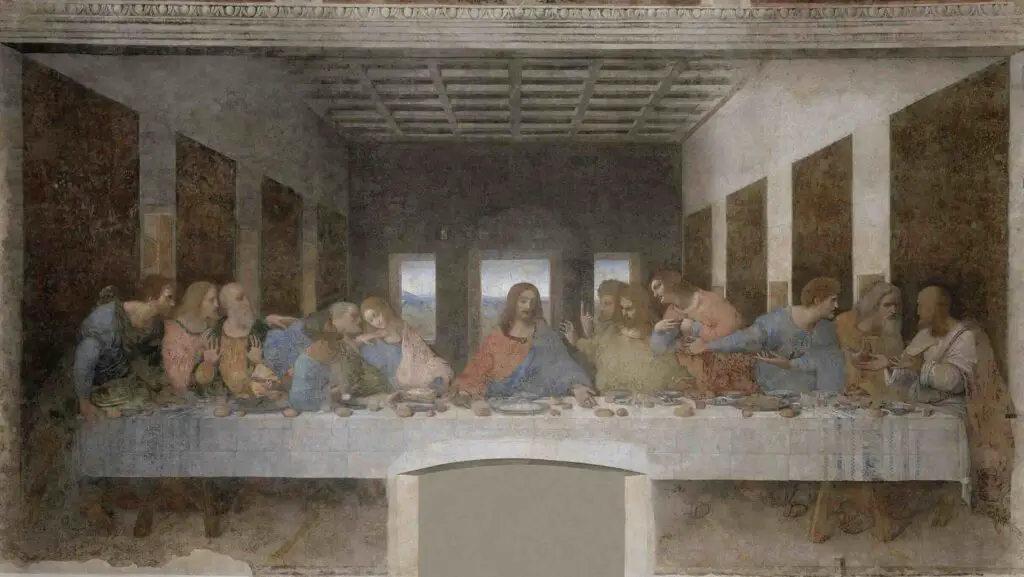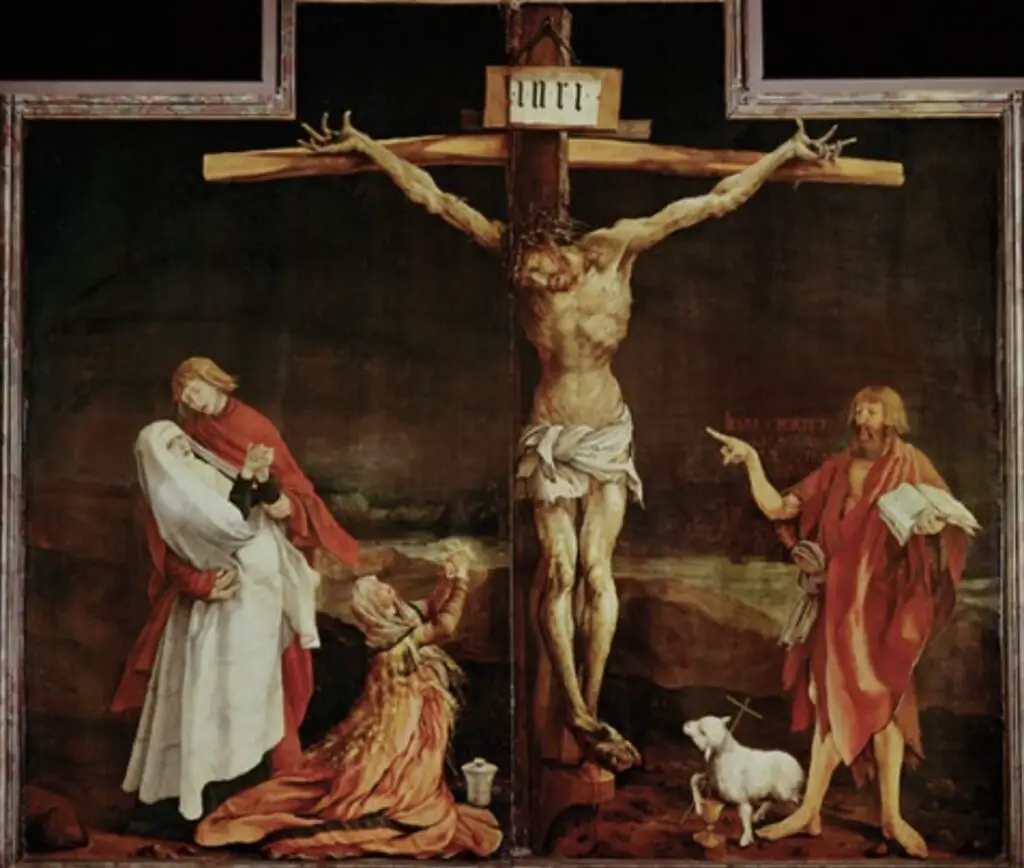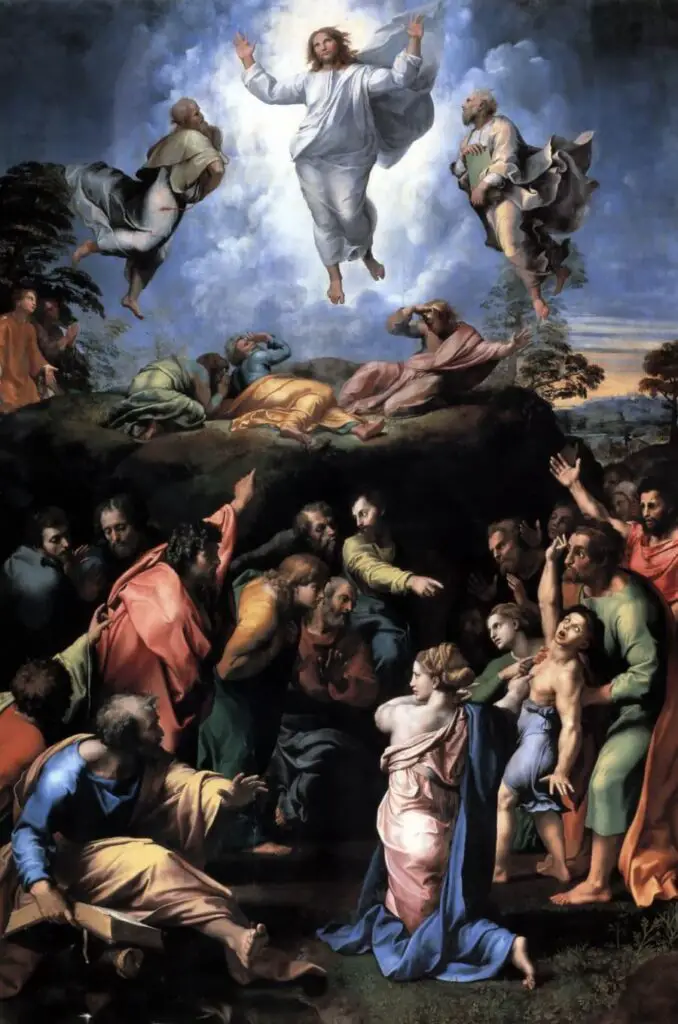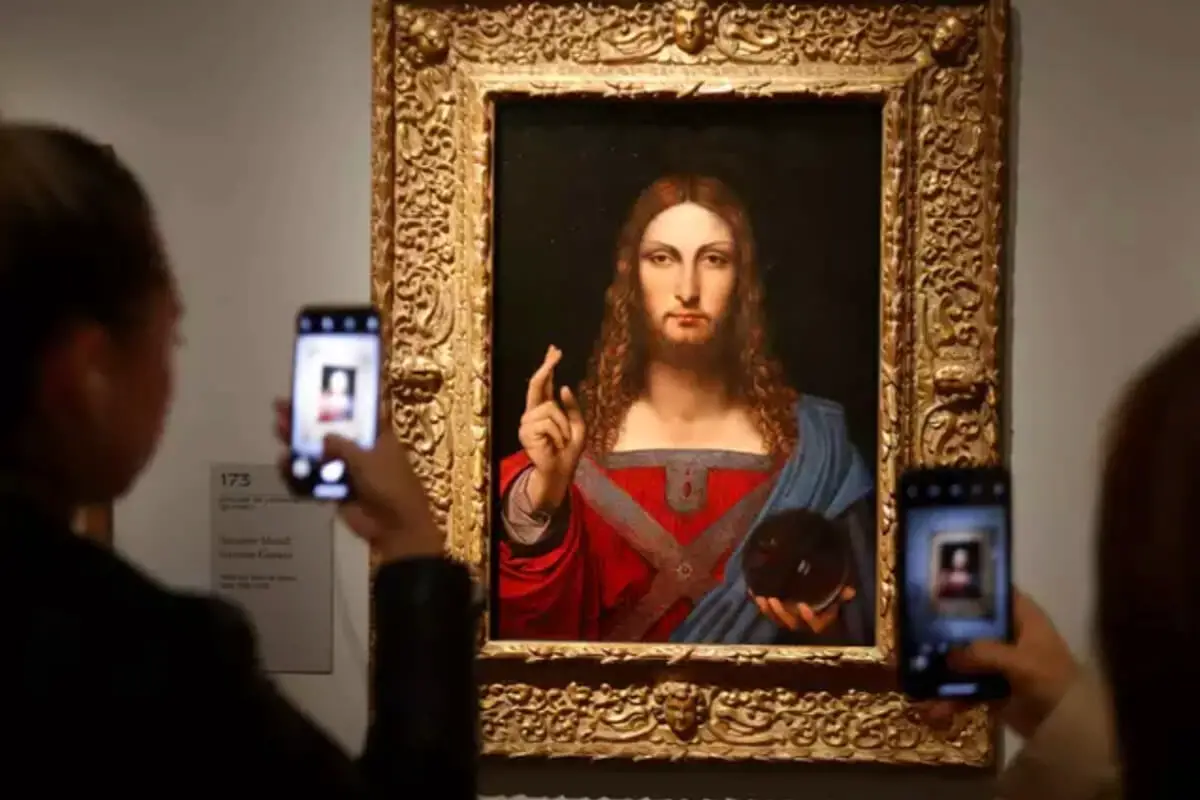Art, in its most profound form, captures moments that speak volumes, transcending time and evoking a spectrum of emotions.
The following discussions shed light on masterpieces that not only present a visual feast but also provoke thought, inviting viewers to engage with historical narratives and theological themes through the lens of artistic brilliance.
Table of Contents
- The Last Supper by Leonardo da Vinci
- The Crucifixion, by Matthias Grünewald
- The Transfiguration by Raphael
- Salvator Mundi by Leonardo da Vinci
- Related Questions
The Last Supper by Leonardo da Vinci
Leonardo da Vinci’s The Last Supper, painted on the walls of Milan’s Convent of Santa Maria delle Grazie, freezes a critical and emotionally charged event in time. It meticulously records the reactions of Jesus’ disciples as he reveals that one of them will betray him. Da Vinci’s work presents a moment so vivid that viewers can practically hear the gasps of disbelief, a testament to the artist’s genius in capturing human emotion.

Each apostle’s response to Jesus’s announcement is unique, showcasing a varied spectrum of shock, denial, and inquiry. This range underlines da Vinci’s exceptional skill in portraying complex psychological states. The grouping of the apostles into three sets introduces a rhythm to the scene, adding to the narrative’s clarity and making the painting a compelling visual story.
Da Vinci’s use of perspective, with Christ at the vanishing point, accentuates his significance in the scene and the broader Christian narrative. This technique directly draws the viewer’s eye to Christ, anchoring him as the calm at the center of an emotional storm. The use of light and shadow further emphasizes this effect, highlighting Jesus’s serene yet somber expression as contrasted with the tumultuous mix of emotions playing across the disciples’ faces.
The table layout and the figures’ positioning convey symbolic meanings. Judas, the betrayer, is set slightly apart from the group, illuminated less than the others, which visually isolates him and marks him as the focus of Jesus’s revelation. The reactions around the table reinforce a sense of immediacy and drama, pulling viewers directly into the biblical story.
Da Vinci incorporates symbolic elements, such as the spilled salt near Judas and the pointed fingers, to foreshadow events to come, enriching the painting’s narrative depth. These finer details encourage viewers to look closer, transforming their experience from passive viewing to active engagement with the narrative’s intricacies.
The Last Supper, with its blend of artistic innovation and emotional depth, captures a pivotal moment in Christian theology and the human experience of betrayal, fellowship, and foreboding.
Da Vinci’s work immerses viewers in this crucial scene, compelling them to ponder its significance and the masterful way it is brought to life. Through this image, Leonardo tells a story and invites participation, making The Last Supper a quintessential narrative moment frozen in time, unmatched in its power to engage and provoke thought.
The Crucifixion, by Matthias Grünewald
Grünewald’s The Crucifixion, unlike other Renaissance representations of the same event, captures an unparalleled intensity of suffering. Every brushstroke intensifies the agony of Christ, turning the canvas into a visceral experience for the viewer.

The exaggerated torment, represented through Christ’s twisted body and the excruciating detail of his wounds, pushes beyond the limits of traditional depiction. This is no sanitized portrayal; it is raw and unflinching.
The dark, almost suffocating palette used by Grünewald further pulls viewers into the depths of despair. The somber colors do more than set the scene; they evoke profound mourning and loss. It’s as if the darkness itself mourns Christ’s suffering.
Adding a unique narrative twist, John the Baptist’s presence introduces a theological dialogue within the painting that extends beyond the crucifixion itself. His pointing towards Jesus while holding a lamb emphasizes the notion of Jesus as the sacrificial Lamb of God, intertwining themes of sacrifice, redemption, and eventual resurrection. This adds layers of meaning to an already complex scene, inviting viewers to deeply observe and contemplate the theological implications.
Moreover, the inclusion of the lamb, pure and unblemished, contrasts sharply with the brutality inflicted upon Christ. This juxtaposition elevates the painting from a mere representation to a profound commentary on innocence, sacrifice, and divine love.
Grünewald’s attention to detail does not stop at the physical suffering but extends to the emotional turmoil of the figures surrounding Christ. The expressions of Mary, Mary Magdalene, and John the Evangelist have depicted with such intensity that their grief becomes palpable. This communal sorrow brings humanity to the divine ordeal, bridging the celestial with the earthly.
The painter’s willingness to explore the extremes of human suffering and divine sacrifice without resorting to idealization sets this work apart. It does not shy away from depicting the grotesque reality of the crucifixion. Instead, it uses it as a tool for deeper spiritual contemplation.
Viewers are not merely spectators; they’re invited into a space of meditation and mourning. This confrontation with pain encourages an empathetic response, further cementing the painting’s role as not just art but as a spiritual exercise.
Through The Crucifixion, Grünewald delivers a powerful message about the nature of sacrifice and the profound depths of Christian love. It challenges, confronts, and ultimately provides a space for reflection on one of Christianity’s most pivotal moments. The raw emotion captured within this painting serves as a reminder of the immense suffering undertaken for redemption, making it a unique and captivating exploration of Christ’s passion.
The Transfiguration by Raphael
With Raphael’s The Transfiguration, viewers are immediately taken aback by the sharp contrast between human turmoil and divine tranquility. The painting masterfully captures a moment of intense human despair met with divine intervention, creating a vivid narrative that bridges the gap between heaven and earth.

At the center of this narrative is the depiction of raw human emotion, as seen in the desperate faces of the apostles and the contorted figure of the possessed boy. Their concern, confusion, and helplessness resonate with viewers, connecting them to the essence of human struggle.
Moving from the chaos below to the tranquility above, Raphael introduces a realm of divine mystery surrounding Christ’s figure. Floating serenely above the earthly scene, Christ is enveloped in a radiant light that signifies His divine nature and the ultimate salvation He brings. Christ’s posture and gaze bridge the distinct separation between the two realms, creating an invisible line that not only connects but also elevates the viewer’s understanding from mere human struggle to divine promise.
Raphael’s choice of color further accentuates this blend of human emotion and divine mystery. The earthly realm is characterized by darker, muted tones, which bolster the apostles’ feelings of despair and confusion. In stark contrast, the divine realm is painted with brighter, more luminous colors that highlight Christ’s transcendence and the serene hope He represents.
This deliberate use of color not only distinguishes between the two worlds but also enhances the emotional depth of each, guiding the viewer through a spectrum of feelings from despair to awe.
The juxtaposition of the two realms in The Transfiguration serves as a visual feast and embodies a deeper theological significance. Raphael presents a narrative of hope and salvation, emphasizing that, amidst human suffering and failure, divine grace remains ever-present and accessible. This painting invites viewers to reflect on their own experiences of despair and hope, connecting them to a universal narrative that transcends time.
Remarkably, Raphael employs spatial techniques to magnify the emotional and spiritual impact of the painting. The characters in the earthly realm are huddled and compressed, amplifying their emotional intensity and sense of urgency.
On the other hand, Christ and the figures in the divine realm are spaced more generously, denoting a sense of peace and otherworldliness. This contrasts their emotional states and subtly guides the viewer’s eye upward toward the divine mystery, simulating an emotional and spiritual ascension.
In its entirety, The Transfiguration adeptly blends human emotion with divine mystery, serving as a profound commentary on the human condition. Through striking contrasts, thoughtful composition, and deep symbolism, Raphael successfully conveys complex theological ideas in an emotionally resonant and visually stunning way.
His ability to capture both the depths of human despair and the heights of divine glory in a single frame makes The Transfiguration a masterpiece that continues to inspire and captivate audiences, inviting them into a meditative journey of faith, hope, and salvation.
Salvator Mundi by Leonardo da Vinci
Shifting the focus to “Salvator Mundi,” we delve into a different enigma surrounding one of the most debated artworks attributed to Leonardo da Vinci. The painting’s controversy primarily stems from its disputed authenticity, with scholars and art critics divided over whether it is solely the creation of da Vinci or the product of his workshop collaboration.

Despite these disputes, the painting sold for an eye-watering $450.3 million in 2017, setting a new benchmark for the art auction world and fueling further discussion about its provenance.
Central to “Salvator Mundi’s” allure is its portrayal of Christ, dubbed the “Savior of the World.” Unlike any traditional depiction, Christ is showcased, holding a transparent crystal orb in one hand, a detail that instantly sets this painting apart.
The orb lacks the expected optical distortions, a curious anomaly when held against Leonardo’s renowned understanding of light and optics. This discrepancy has ignited speculation among art lovers and scientists alike, pondering whether it was a deliberate theological statement by the artist or a symbolic concession.
In addition to the orb’s charisma, the position of Christ’s other hand, raised in a gesture of blessing, navigates viewers through Renaissance subtleties and theological assertions. This iconic hand gesture, coupled with the serene, almost ethereal demeanor of Christ’s face, mirrors the hauntingly captivating smile of Leonardo’s Mona Lisa, underscoring the artist’s knack for rendering human expressions that transcend the canvas.
The painting’s fascination doesn’t stop at its symbolic intricacies or debated authenticity; it encompasses the technique employed by da Vinci that imbues the portrait with an ethereal quality.
Through sfumato, a painting technique that allows colors to shade into one another, creating soft transitions devoid of harsh outlines, Leonardo achieves a dream-like quality that further envelopes Christ in mystery. This technique, combined with the ethereal light that seems to radiate from the figure itself, positions “Salvator Mundi” as a portrait and a gateway into the divine.
Despite the controversies surrounding its authorship, “Salvator Mundi” compellingly captures the imagination and curiosity of its beholders. Its representation of Christ is imbued with an ambiguity that invites speculation and exploration, a hallmark of Leonardo’s works. The orb, devoid of realistic refraction, alongside Christ’s enigmatic expression, prompts a multifaceted dialogue about faith, artistry, and the mysteries of the divine.
Further mystique is lent to the painting through its veiled journey across centuries—once lost and later recovered in a tarnished state, its restoration reads like a rebirth narrative, echoing the resurrection theme ever so prevalent in Christian art.
The intertwined themes of redemption, mysticism, and unparalleled artistic skill make “Salvator Mundi” a subject of elusiveness and reverence. It treads a fine line between being a masterpiece shrouded in mystery and a focal point of art forensic scrutiny.
In tracing the captivating essence of “Salvator Mundi,” one uncovers not only an elaborate web spun from theology, optics, and authenticity debates but also a testament to the enduring power of art to provoke thought, invoke deep reflection, and enchant an audience beyond its time. This painting remains a beacon of artistic and spiritual inquiry, steadfast in its controversy yet unwavering in its magnetic appeal.
In the end, the essence of art lies in its power to provoke thought and evoke emotion, serving as a bridge between the viewer and the depths of human experience. Among the myriad artworks discussed, “Salvator Mundi” stands as a testament to this truth, encapsulating the enduring allure of mystery and the profound impact of artistic expression on our understanding of faith, humanity, and the divine.
Anita Louise Art is dedicated to art education, great artists, and inspiring others to find and create their art. We love art that uplifts and inspires. #ArtToMakeYouSmile! #ArtToMakeYouHappy!
If you are interested in seeing any of my art, you can find out more by clicking here. If you are interested in what inspires me and my paintings, you can discover more by clicking here.
We have a free newsletter and would love you to be part of our community; you can subscribe to the newsletter by clicking here. If you have any questions, I would be happy to talk to you. You can reach me, Anita, by clicking here.
Subscribe to our Anita Louise Art YouTube Channel filled with great videos and information by clicking here.
Join us for our podcast “5 Minutes With Art.” Spend just 5 minutes a week with us to discover and learn about great art and artists. You can find out more about our podcast by clicking here.
Related Questions
Did Michelangelo And Leonardo Know Each Other?
Michelangelo and Leonardo da Vinci knew each other but were considered bitter rivals. Leonardo da Vinci and Michelangelo knew each other, but they did like each other. They were both asked to do a commission on the Council Hall of the Palazzo Vecchio and were supposed to work side-by-side; the project was never completed.
By clicking here, you can learn more by reading Did Michelangelo And Leonardo Know Each Other?.
What Was The Focus Of Renaissance Art?
The focus of Renaissance art was on the classics of Greek and Rome, humanist philosophy, and the study of the human figure. Realism was also an essential part of renaissance art. The great artists of the Renaissance also became great anatomists and studied human beings.
By clicking here, you can learn more by reading What Was The Focus Of Renaissance Art?.
Michelangelo’s Method To Paint The Sistine Chapel Ceiling
He built a large scaffolding structure that could move around the chapel to paint the ceiling; the painting of the Sistine Chapel was an extremely strenuous work that was a huge personal cost both physically and mentally to Michelangelo.
By clicking here, you can learn more by reading Michelangelo’s Method To Paint The Sistine Chapel Ceiling.


